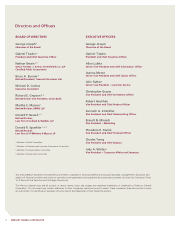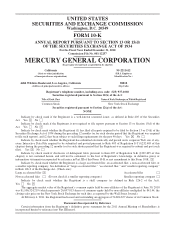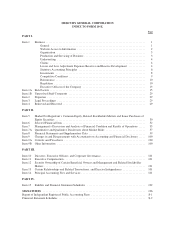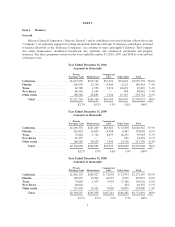Mercury Insurance 2010 Annual Report Download - page 18
Download and view the complete annual report
Please find page 18 of the 2010 Mercury Insurance annual report below. You can navigate through the pages in the report by either clicking on the pages listed below, or by using the keyword search tool below to find specific information within the annual report.
Investments
The Company’s investments are directed by the Chief Investment Officer under the supervision of the Board
of Directors. The Company’s investment strategy emphasizes safety of principal and consistent income
generation, within a total return framework. The investment strategy has historically focused on maximizing
after-tax yield with a primary emphasis on maintaining a well diversified, investment grade, fixed income
portfolio to support the underlying liabilities and achieve a return on capital and profitable growth. The Company
believes that investment yield is maximized by selecting assets that perform favorably on a long-term basis and
by disposing of certain assets to enhance after-tax yield and minimize the potential effect of downgrades and
defaults. The Company believes that this strategy maintains the optimal investment performance necessary to
sustain investment income over time. The Company’s portfolio management approach utilizes a market risk and
asset allocation strategy as the primary basis for the allocation of interest sensitive, liquid and credit assets as
well as for monitoring credit exposure and diversification requirements. Within the ranges set by the asset
allocation strategy, tactical investment decisions are made in consideration of prevailing market conditions.
Tax considerations, including the impact of the alternative minimum tax (“AMT”), are important in
portfolio management. Changes in loss experience, growth rates, and profitability produce significant changes in
the Company’s exposure to AMT liability, requiring appropriate shifts in the investment asset mix between
taxable bonds, tax-exempt bonds, and equities in order to maximize after-tax yield. The Company closely
monitors the timing and recognition of capital gains and losses to maximize the realization of any deferred tax
assets arising from capital losses. At December 31, 2010, the Company had a capital loss carry forward of
approximately $42.1 million.
Investment Portfolio
The following table presents the composition of the Company’s total investment portfolio:
December 31,
2010 2009 2008
Cost(1) Fair Value Cost(1) Fair Value Cost(1) Fair Value
(Amounts in thousands)
Taxable bonds .................... $ 200,468 $ 223,017 $ 261,645 $ 270,093 $ 362,147 $ 299,561
Tax-exempt state and municipal
bonds ......................... 2,417,188 2,429,263 2,411,434 2,434,468 2,360,874 2,179,178
Redeemable preferred stocks ......... ————5,450 2,934
Total fixed maturities ........... 2,617,656 2,652,280 2,673,079 2,704,561 2,728,471 2,481,673
Equity investments including
non-redeemable preferred stocks .... 336,757 359,606 308,941 286,131 403,773 247,391
Short-term investments ............. 143,378 143,371 156,126 156,165 208,278 204,756
Total investments .............. $3,097,791 $3,155,257 $3,138,146 $3,146,857 $3,340,522 $2,933,820
(1) Fixed maturities and short-term bonds at amortized cost and equities and other short-term investments at
cost.
The Company applies the fair value option to all fixed maturity and equity securities and short-term
investments as of the time the eligible item is first recognized. For more detailed discussion, see “Liquidity and
Capital Resources—Invested Assets” in “Item 7. Management’s Discussion and Analysis of Financial Condition
and Results of Operations” and Note 2 of Notes to Consolidated Financial Statements.
At December 31, 2010, 77.0% of the Company’s total investment portfolio at fair value and 91.6% of its
total fixed maturity investments at fair value were invested in tax-exempt state and municipal bonds. For more
detailed information including credit ratings, see “Liquidity and Capital Resources—Portfolio Composition” in
“Item 7. Management’s Discussion and Analysis of Financial Condition and Results of Operations.”
8
























